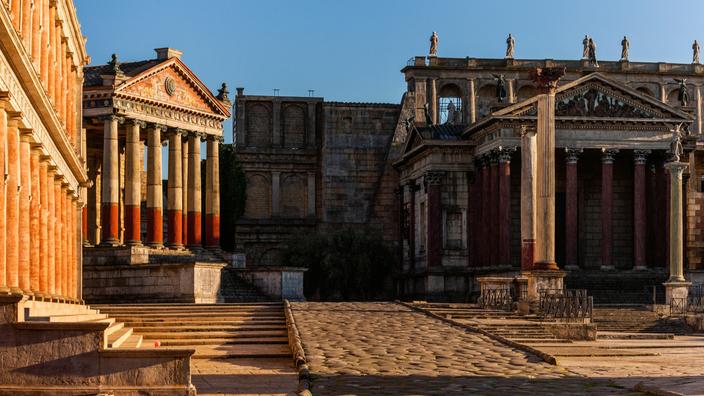Visitors walk through a reconstruction of a Roman forum dominated by polychrome hexastyle temples, a large portico, cobbled streets. Further on, the colonnades thicken to support the more crude foundations of the reconstructed Temple of Jerusalem or the clean facades of a Renaissance Florence. Eternally associated with the golden age of Italian cinema, the Cinecittà studios in Rome and their current astonishing settings impress many, despite the long standing erasure of this cinema complex in the face of international competition. But this almost century-old jewel of European cinema could soon regain its former glory, thanks to funds from the European recovery plan. An unexpected windfall that should revive theattractiveness of this historic cinema complex, trumpets the studio management.
To discover
The peasant humor of Bodins does not make Paris laugh
Read also Cinecitta on the way to a new dolce vita
The legendary Cinecittà -
“the city of cinema
” in Italian - and its film sets were used in particular for the production of the
Rome
series
of the American channel HBO, as well as for season 6 of
Kaamelott
. Passed under public control in 2017, they will receive 260 million euros from the new European plan, including 172 million dedicated to adapting production capacity: doubling the surface area of the studios (which currently cover 40 hectares) - , creation of five new platforms and the reconstruction and expansion of five others. Twelve million euros will also finance an indoor swimming pool for underwater filming, a theater with a 360 ° green screen and two sets for virtual reality with LED panels.
Visitors walk through the reconstruction of the Temple of Jerusalem in November 2021 at the Cinecittà studios in Rome. LAURENT EMMANUEL / AFP
The idea is simple: to remake Cinecittà, by 2026,
"an important European cinematographic center
", able to compete with the British studios of Pinewood and Shepperton near London, Babelsberg in Germany and Korda in Hungary.
"For Cinecittà, this is really a unique opportunity, because it brings together two situations that are difficult to reproduce: the recovery plan and a booming market,"
Nicola Maccanico, director general of Cinecittà, told AFP.
It is in this market context that the idea of relaunching Cinecittà was born (...) with the idea of making it a reference pole for the new audiovisual production market in Europe
”. If successful,
"We would give it back the light that characterizes it and that it deserves"
.
Read alsoDive into the golden age of Cinecittà
The delay of the studios is however significant.
Unable to meet market demand - exponentially with series and TV programs - Cinecittà is giving up 25 million euros in turnover per year, according to the business daily
IlSole24ore
.
Future investments are thus all the more favorable for studios as the sector, in Italy, is on the rise.
According to the European Audiovisual Observatory, Italy was the most prolific European country on the continent, in 2019, with 312 national productions, against 240 in France and 237 in Germany.
La Venusia
, exhibited in the Roman studios of Cinecittà.
This sculpture by Italian scenographer Giantito Burchiellaro was produced for
Fellini's Le Casanova
, released in 1976. Laurent EMMANUEL / AFP
The historic studios of the Eternal City
Formerly called "
Hollywood on the Tiber
", Cinecittà has seen the birth of more than 3,000 films, including 51 Oscar winners. International giants like
Ben-Hur
(1959) by William Wyler or iconic films like
La Dolce Vita
(1960) by Federico Fellini were filmed there. Inaugurated in 1937 on the southern outskirts of the capital as a Mussolini propaganda machine, the studios have witnessed the various upheavals in the contemporary history of Italy: fascism, the Allied bombings of 1944, the use of the studios as housing for people displaced by the war, the economic
“miracle”
of the 1950s and 1960s, then the decline.
Read also Cinecittà dedicates a retrospective to Venantino, the gunslinger of the
Tontons
Competition from television, the crisis in the Italian film industry and the abandonment of major international productions have relegated
"the factory of dreams"
to the hierarchy of major studios since the end of the 1960s. However, blockbusters are still sometimes there. tours, as was the case of
Gangs of New York
by Martin Scorsese (2002),
Angels and Demons
by Ron Howard (2009) or
6 Underground
by Michael Bay (2019). But these major international productions are rare. To diversify its sources of income, Cinecittà opened its doors to the public in 2011. Groups of Italian and foreign tourists stroll between the studios, the best known of which is the imposing Teatro 5 - Fellini's favorite and the largest in Europe -, or stroll through the open-air settings of ancient Rome or of Florence from the 15th century.
"Some Hollywood studios are in the same state as Cinecittà, that is to say in a form of crisis, and the opening of the studios to the public is a way of balancing the accounts"
, explained to AFP Jean Gili, critic and professor emeritus at the University of Paris 1 Panthéon-Sorbonne.
Since then, a cinema-themed amusement park - Cinecittà World - also rose from the ground in the suburbs of Rome in 2014, designed by multi-Oscar-winning Italian decorator Dante Ferretti.
So many touristification efforts that will perhaps be interrupted during the future major works of the site.
Cinecittà, like Rome, was not built in a day.

